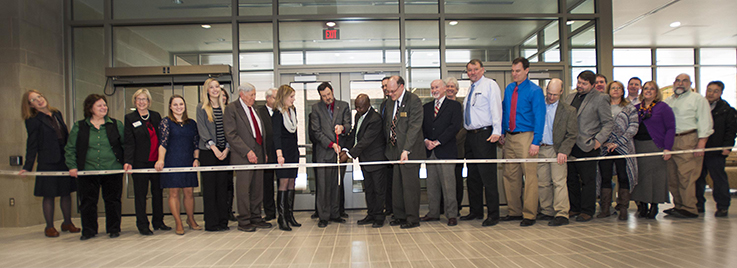 Indiana University of Pennsylvania formally cut the ribbon on Friday, January 22, 2016, for its new $30-million academic building, which houses seven departments in the College of Humanities and Social Sciences.
Indiana University of Pennsylvania formally cut the ribbon on Friday, January 22, 2016, for its new $30-million academic building, which houses seven departments in the College of Humanities and Social Sciences.
The building, located next to Stapleton Library and facing Grant Street, houses the departments of English, Geography and Regional Planning, History, Journalism and Public Relations, Philosophy, Political Science, and Religious Studies. It also is home to these centers, institutes, and area studies: the Frederick Douglass Institute for Intercultural Research; Mid-Atlantic Research and Training Institute for Community and Behavioral Health; Center for Northern Appalachian Studies; Asian Studies program; Latin American Studies program; Lesbian, Gay, Bisexual, Transgender, and Queer Studies program; Pan-African Studies program; Sustainability Studies program; and Women's and Gender Studies program.
All undergraduate students will attend a class in this new building, as will many master's- and doctoral-level students.
IUP President Michael Driscoll noted during the ceremony that the new facility offers “a variety of spaces for a variety of learning, the formal and the informal, and places where new discoveries can be made and shared.”
“In many ways, this new building symbolizes the very essence of IUP, a learning community where collaboration, inspiration, knowledge, and curiosity meet and make a wonderful community,” Driscoll said.
The ceremony also included remarks from Timothy Moerland, IUP provost and vice president for academic affairs; Gealy Wallwork, a member of the IUP Council of Trustees; state Rep. Dave Reed, a 2000 graduate of IUP and a member of the IUP Alumni Association Board of Directors, via video message; Yaw Asamoah, dean of the College of Humanities and Social Sciences; Charles Cashdollar, IUP professor emeritus of history; Gian Pagnucci, chair of the Department of English; and Ashley Niccolai, a 2015 IUP graduate and current graduate student in the Sociology Department.
In addition to 31 classrooms (supporting 1,835 seats) and 120 offices, the 126,505-square-foot building includes a 250-seat auditorium, a great hall, an atrium and sandwich shop, eight conference rooms, two collaborative classrooms, a public artifacts room, specialty classrooms and labs, and a rooftop plaza for academic and social space.
Groundbreaking for the new building took place November 1, 2013. The architect for the building is CannonDesign of Pittsburgh.
Departments moved into the new building from McElhaney, Keith, Leonard, Davis, and Sutton halls. The building also replaces the classrooms and offices of departments that were in Keith and Leonard halls. As part of the university's long-range campus master plan, Keith and Leonard halls will be razed to make space for a new science building and a dining facility.
While the building has been funded by the Department of General Services, private gifts supported additional features. The IUP Ambassadors, a student group, provided support to enhance the first-floor computer lab (room 102), and the Class of 2013 supported the second-floor seating area.
“Many faculty members have financially supported different areas of the building to honor colleagues,” Driscoll said. “I want to say thank you for choosing to place your philanthropic support into our community. These donations illustrate that we are passionate about our work and that, as an institution, we honor our own.”
Alumni and friends supported enhancements to the Wendy Carse Room (504A), the Charles Cashdollar Town Hall (room 304W), and the Irwin Marcus Public History Room (304D). The late Carse was a professor of English; Marcus is a professor emeritus of history.
When Thomas Sutton Hall was razed in the 1970s to make way for Stapleton Library, its stained-glass windows were carefully uninstalled. Four of them were reinstalled in the library; 10 were placed in storage. A gift from the Class of 2014 enabled the university to engage Peter Jandura, of Connellsville, to restore the remaining windows, which are on display in the first-floor lobby area and on the third floor, in the College Commons and near the History Department.
Thirteen paintings by Vaughn Clay, art professor emeritus, have been installed throughout the building, as have 14 photographs by local artist Bill Double, a retired art and theater educator, former University Museum board president, and current museum board member and installations coordinator.
Photo Information: Chairpersons of the departments housed in the new Humanities and Social Sciences building, along with the speakers during the event, formally cut the ribbon for the new building.